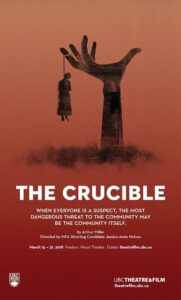The Seen or the Unseen: Make Justice Blind Again
By M. Doğukan Kuru

The Crucible (1953) by Arthur Miller dramatizes the Salem witch trials that took place during 1692-93 in Massachusetts, USA. It is a play written during McCarthy’s infamous “red scare,” which involved numerous prosecutions and trials against suspected communists in the early years of the Cold War. The play tells the story of the events leading up to the trials, which were conducted by the official secular judiciary branches of the government on biblical grounds. The initial scene begins with a child, Abigail, lying ill in bed, while the town’s reverend, Parris, tries to wake her up. Abigail is later discovered in the woods, dancing naked and singing songs with her female companions from the same town. Engaging in forbidden acts, Abigail and her friends are suspected of befriending the Devil and practicing witchcraft. Reverend Parris, on the other hand, wants to dispel these suspicions in order to protect his reputation, as Abigail lives under his roof. As more people become involved, the growing suspicions of the Devil sending witches to the town unsettle the residents of Salem. Old and new grudges resurface, leading to accusations against one another. Prominent members of the town suddenly become suspects of collaborating with the Devil, and the malicious children become the perceived authority in the eyes of the officials. As the trials commence in town, under the pretext that there are witches aligned with the Devil, the complex relationships characterized by clan alliances, land disputes, and personal grudges set the stage for justice, expanding the scope of the trials day by day to encompass the entire town population. Empowered to hang those found guilty, the official court summons suspects of all ages to appear before them based on the accusations made by a group of children. Pretense becomes the de facto evidence of the crime, as the desired outcome is to uncover metaphysical entities unseen by any possible witnesses. Anxiety permeates the residents of Salem as they seek ways to benefit at the expense of others or to avoid the noose. Relationships among residents prove hostile and distrustful. The laws of men are manipulated with the hope of personal gain, echoing the climate of anxiety prevalent at the time the play was written. The town of Salem finds itself in turmoil as people blame one another with flimsy or nonexistent evidence. Through the actions of its citizens, the play illustrates the vulnerability of the judicial system to manipulation, revealing its imperfections. This weakness is evident not only by examining the flaws within the system but also through public opinion regarding the concept of the rule of law. The trials held under the premise that an unobservable phenomenon had struck Salem are conducted with dogmatic references and superficial evidence. Similar to McCarthyism, the Salem mindset becomes oppressive in its efforts to conform society to the hegemony’s dictates. Baptized Christians in Salem, esteemed citizens in the US, all face accusations based on pretenses stemming from institutional or personal grudges.

